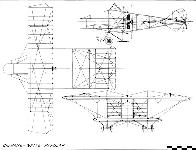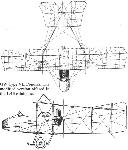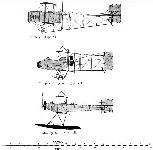P.Lewis British Aircraft 1809-1914 (Putnam)
Grahame-White Type 7 Popular
Claude Grahame-White devoted a great deal of his time towards popularising flying and, to this end, asked J. D. North to design a small, cheap and easy-to-produce aeroplane. North set to work and, in January, 1913, there appeared the Type 7 Popular for use as a school machine and for sporting flying.
The Farman-style pusher layout was followed, and the prototype was equipped with the 35 h.p. three-cylinder Anzani engine. Effective lateral control was ensured by the fitting of 7 ft. long ailerons, extending from the tail booms to the tips of the upper wings. The lower wings were of very short span, being but 14 ft. compared with the upper span of 28 ft., and the sole bracing for the long overhang of the upper wings was provided by king-posts and wire. Tandem seating for two was provided in the enclosed nacelle, and a one-piece elevator was fitted at the rear. The Type 7 was not fitted with a tail-skid, take-off and landing being effected on the main wheels and their laminated skids.
The production version of the Popular was given increased power in the form of the 50 h.p. Gnome, and this engine was fitted to both the single-seat and two-seat models. At the time at which the Popular was built, the majority of aeroplanes cost about ?1,000. Its own price of under ?400 was a praiseworthy attempt to place on the market a machine at a reasonable price without compromising standards of safety, economy and comfort.
SPECIFICATION
Description: Two-seat pusher biplane. Wooden structure, fabric covered.
Manufacturers: Grahame-White Aviation Co. Ltd., Hendon, London, N.W.9.
Power Plant: 35 h.p. Anzani, 50 h.p. Gnome.
Dimensions: Span, 28 ft. Length, 23 ft. 6 ins. Wing area, 205 sq. ft.
Performance: Maximum speed, 50 m.p.h. Endurance, 4 hrs.
Price: Under ?400.
Показать полностью
M.Goodall, A.Tagg British Aircraft before the Great War (Schiffer)
Deleted by request of (c)Schiffer Publishing
GRAHAME-WHITE Popular biplane Type VII
The single-seat Popular, designed by J.D. North, appeared at Hendon in the last week of January 1913. It was also offered as a two-seater with 50hp Gnome, which was apparently not built. The single aircraft built was acquired by the War Office as No.283 in March 1913.
The wide spaced booms tapered to the tail in side view and, together with the very short span lower wing, gave the machine a gawky appearance, not enhanced by the wide track undercarriage and squarish nacelle. The top wing was fitted with ailerons and there was a full width elevator and divided rudder. The machine rested on its four wheels and rear portions of the main skids; there was no separate tail-skid.
Power: 35hp Anzani three-cylinder air-cooled Y-type radial driving a 7ft diameter GW propeller
Data
Span top 28ft.
Span bottom 14ft
Chord 5ft 3in
Area 205 sq ft
Area tailplane 20 sq ft
Area elevator 14 sq ft
Area rudder 10 sq ft
Length 23ft 6in
Speed range 4060 mph
Price ?400
GRAHAME-WHITE Popular passenger biplane Type VIIC
Derived from the Boxkite, rather than the Popular Type VII, this appears to be a variation evolved in the works under Mr. Bill Law, the superintendent, prior to the appointment of J.D. North as chief designer.
The obvious differences were the removal of the front booms and elevator, and the fitting of a projecting nacelle. The tail booms were apparently raked downwards. This machine was acquired by the War Office in March 1913 and identified as serial No.354 at Farnborough.
Power: 70hp Gnome seven-cylinder air-cooled rotary driving a 8ft 6in diameter propeller.
Data
Span 38ft
Chord 6ft 3in
Gap 5ft 10in
Area 475 sq ft
Area tailplane 40 sq ft
Area elevator 9 1/2 sq ft
Area rudder 14 sq ft
Length 26ft 10in
Height 9ft 10in
Speed 45 mph
Endurance 4hr
GRAHAME-WHITE Popular biplane Type VII (1913 version)
A considerably different version of the Type VII appeared in the Grahame-White catalogue of 1913. This is the version that would have been built if orders had been received. The main difference from the version flown was in the tail structure. The tail booms tapered in plan to a point at the rear and were virtually parallel in side elevation. The nacelle was of an improved rounded shape and was lowered onto the bottom wing. The tailplane, with divided elevator, was fitted on the top longerons, together with a tall, one piece rudder and sprung tail-skid, which enabled the main skids to be reduced in length.
Power:
Type A 35hp Anzani three-cylinder Y type radial driving a 7ft diameter GW propeller
Type B 50hp Gnome seven-cylinder air-cooled rotary driving a 8ft diameter propeller.
Data
Span top 29ft 2in
Span bottom 17ft
Chord 5ft
Gap 5ft
Area 230 sq ft
Area tailplane 28 sq ft
Area elevator 20 sq ft
Area rudder 12 sq ft
Speed Type A 45-50mph
Speed Type B 50-60mph
Endurance 4hr
Price Type A ?400
Price Type B ?660
Показать полностью
Jane's All The World Aircraft 1913
GRAHAME-WHITE. The Grahame-White Aviation Co., Ltd., 166 Piccadilly, London, W. Works and Flying Ground: Hendon. Founded by C. Grahame-White, the well-known aviator, who in 1909 commenced operations with a school at Pau. Later this was removed to England, and a general agency for the sale of aeroplanes, etc., established. This developed, and early in 1911 the firm was handling a special British agency for the U.S. Burgess type known as "The Baby." The Hendon Aerodrome was acquired, and a factory established, which has grown continually ever since. In April, 1912, a monoplane to special design was completed. By the close of the same year biplanes of advanced design were constructed. Capacity of the works, March, 1913, was equal to 150 machines a year if necessary.
| 1913. |1913. |1913. |1913 |1913.
|Military |"Popular" |"Popular" |Tractor |Monoplane.
|biplane. | biplane |biplane |hydro- |Type IX.
|Type VI. |Type VII. |Type VII. |biplane | single-
|2-seater |2-seater. |2-seater. |2-seater.| seat.
-----------------|-----------|-------------|-------------|---------|----------
Length...feet(m.)|33? (10.10)|20-5/6 (6.40)|26-5/6 (8.22)|25 (7.60)|21 (6.40)Span.....feet(m.}|42 (12.80)|29-1/6 (8.85)|38 (11.60)|42? (13) |32 (9.75)
Area..sq.ft.(m?.)|435 (40?) |230 (21) |475 (44) |380 (35) |208 (19)
Weight, total ...| | | | |
.......lbs.(kgs.)|2200 (997) | ... | ... |850 (385)| ... Weight, useful...| | | | |
.......lbs.(kgs.)| 750 (340) | ... | ... |450 (204)| ...
Motor | 120 Aust. | 50 Gnome | 50 Gnome |80 Gnome |50 Gnome
| Daimler | | | |
Speed, max... | | | | |
...m.p.h (k.p.h.)|70 (110) |60 (95) |50 (80) |65 (105) |65 (105)
Speed, min... | | | | |
...m.p.h (k.p.h.)|55 (90) |50 (80) |40 (65) |50 (80) | ... Endurance....hrs.| 6 | 4 | 4 | 4 | 4
Number built | | | | |
during 1912 | 1 | ... | ... | 1 | ...
-----------------|-----------|-------------|-----------------------|-----------
|Also built | Also built | |Also built|Also built
|with a 90 | with a 35 | |with a 60 |with a 35
|Aust.Daimler.| Anzani. | |Anzani. |Anzani. Two
|Designed to| | | |main floats
|carry a gun| | | |with 12?
|on the bow.| | | |ft. track.
|Very good | | | |Floats are
|view. Very | | | |15 ft.long,
|strong | | | |2 ft. wide,
|landing | | | |1 ft. 3 in.
|carriage. | | | |deep.
Показать полностью
Журнал Flight
Flight, February 1, 1913.
THE 35-H.P. GRAHAME-WHITE "POPULAR" BIPLANE.
LISTED at a price of under L400 complete with motor and all the usual accessories, this interesting product of the Grahame-White Co., which only made its appearance during the past week, is essentially the machine for the man of moderate means. It is small, light, inexpensive in first cost and upkeep, simple and cheap to repair, and by no means difficult, we should think, to fly. Thus it makes a strong appeal to the exhibition flyer, the flying school proprietor, and the man who takes up aviation as a sport. Considering the latter type of man, there are very few, and they are very far between, who quite see the point of laying out the more usual price of L1,000 in acquiring a machine with which he can make an occasional cross-country flight. There ought to be many comfortably well off sportsmen who would take up flying as a hobby if it were only brought home to them that flying need not be such an expensive diversion as has been generally thought. For, after all, there is no fascination to compare with the fascination of flying.
In general outline, as the reader will gather from our photographs, this new Grahame-White machine bears a resemblance to that very well-known French make of biplane - the Henry Farman. To our way of thinking this fact does not make the machine any the less interesting. Rather do we admire the Grahame-White Co.'s policy in basing their machine on a design that, in France, has probably brought its originators a greater commercial success than has been achieved by any other aeroplane manufacturing firm we could mention.
The main lifting surfaces of the machine are constituted by two planes, 28 ft. and 14 ft. respectively, in span, set at an angle of 5 of incidence, and braced together by heavy-gauge piano wire and separated by eight hollow struts in two ranks. The four centre struts - for they support the body - are of ash, the outer ones are of spruce. The planes are built about two main ash spars, both of I-section, and the ribs occur at every foot, approximately, along their length. At those points at which vertical struts are attached to the spars, the ribs used are of the hollow box variety in other places, they are built up, I-section, with spruce flanges and three-ply distance pieces. To better maintain the shape of the plane, false ribs, extending from the leading edge to the front spar, are arranged midway between each main rib, and a pair of longitudinal stringers are run, at a point midway between front and rear spars, from one end of the plane to the other. The cross-section employed is that of the later 50-h.p. Gnome-Bleriot wing, the one that Eiffel refers to in his work on wing sections as Aile No. 13 bis. Lateral control of the machine is maintained by two balancing flaps, each of 7 ft. span, hinged to the rear spar at either end of the top plane. They work in conjunction, and are connected one to the other by stranded steel cables, which pass over red fibre pulleys clamped to the front spar.
The landing-gear is of a type which, if it cannot be said of it that it is original, still maintains its own as probably the most serviceable type of undercarriage ever devised. The skids are of ash, and each supports its side of the machine through two vertical ash struts and three steel tubes, which are arranged to give the maximum of rigidity. Throughout, its length between the attachments of the vertical struts, each skid is spindled down to an I-section, and the overhang behind the rear vertical strut is laminated and made flexible in such a way that it may take the weight in landing of the rear part of the machine. Thus we find that the tail skid has been suppressed, as it has been in many machines of late. Of the strength of the chassis there can be little doubt, since the struts have an ample cross-section, and they are only about 18 ins. in length.
Ash outriggers support the tail, and they arc braced by a steel wire and by vertical hollow wooden struts, and horizontal steel tubes. For lightness' sake the outriggers are hollowed out to I-section between those points where bolts pass through them to anchor the sockets accommodating the vertical and horizontal cross-members. The tail, being cambered and set at a positive angle of 20, does a small share of the total lift. Behind it are the two elevator-flaps by which the attitude of the machine is controlled.
The body of the machine, in which the pilot sits, where are accommodated the fuel tanks, and to which the motor is mounted, is essentially a box girder some 12 ft. in length, built up of ash longitudinals, cross-members of oval-section steel tubing, and vertical members of spruce and ash. It is enclosed in front by three-ply wood, and along its sides by fabric. At its rear end it is capped by a flanged steel plate, to which the motor, a 35-h.p. Anzani of the very popular Y-type, is bolted. It drives a propeller of 2.100 m. diameter and 1.500 m. pitch. This propeller, by the way, has been designed by Mr. J. D. North, who is also responsible for the general and detail design of the machine under review. In shape it is somewhat reminiscent of, and yet unlike, the Levasseur propeller, for the fact that its blades, scythe-shaped, revolve point first. The cross-section of its blades, however, is different, for, on what may be considered as the under surface of the blade, Mr. North has made use of the return curve. It is interesting to record that a static thrust of 310 lbs. has been obtained from an exactly similar propeller driven by a similar engine.
Including four hours' supply of petrol and oil, and with the pilot on board, the weight of the machine comes out at slightly over 600 lbs., and thus its surface loading is, approximately speaking, 3 lbs. to the sq. ft. Its average flying speed is estimated at 50 miles an hour.
Показать полностью









